Click on images to enlarge
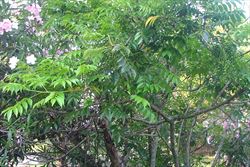
habit in spring with immature fruit (Photo: Sheldon Navie)
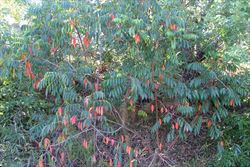
habit in late summer (Photo: Sheldon Navie)

habit in autumn with mature fruit and bright red leaves (Photo: Land Protection, QDNRW)
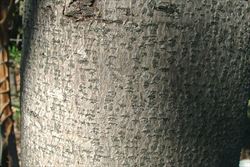
close-up of bark on main trunk (Photo: Sheldon Navie)

young leaves in spring (Photo: Sheldon Navie)

once-compound leaf with several pairs of leaflets and a single terminal leaflet (Photo: Sheldon Navie)
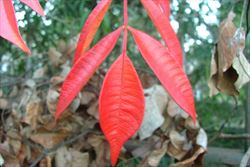
close-up of leaflets in autumn (Photo: Sheldon Navie)
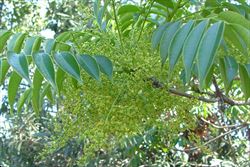
large clusters of greenish-yellow flowers (Photo: Sheldon Navie)
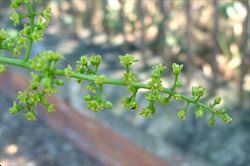
close-up of the inconspicuous flowers (Photo: Sheldon Navie)

cluster of immature fruit (Photo: Sheldon Navie)

close-up of immature fruit (Photo: Sheldon Navie)

autumn leaves and clusters of mature fruit (Photo: Jackie Miles)
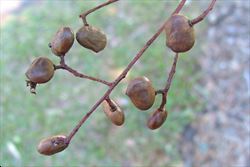
close-up of mature fruit (Photo: Sheldon Navie)

vigorous suckering from the base of a damaged plant (Photo: Sheldon Navie)
Scientific Name
Toxicodendron succedaneum (L.) Kuntze
Synonyms
Rhus succedanea L.Toxicodendron succedanea (L.) Mold.
Family
Anacardiaceae
Common Names
Japanese lacquer tree, Japanese tallow tree, Japanese wax, Japanese wax tree, Japanese waxtree, poison ivy, poison sumac, rhus, rhus tree, scarlet rhus, sumac, varnish tree, wax tree, waxtree
Origin
Native to the Indian Sub-continent (i.e. Bhutan, Nepal, northern India and northern Pakistan) and eastern Asia (i.e. China, Japan, Taiwan, Cambodia, Laos, Myanmar, Thailand, Vietnam and western Indonesia).
Cultivation
Rhus tree (Toxicodendron succedaneum) has been widely cultivated as a garden and street tree, particularly in the temperate regions of Australia. It was usually grown for its brightly-coloured autumn foliage.
Naturalised Distribution
Locally naturalised in the coastal districts of central New South Wales and sparingly naturalised in south-eastern Queensland.
Habitat
A potential weed of disturbed sites, forests, open woodlands, urban bushland, roadsides, gardens and waste areas in temperate and sub-tropical regions.
Habit
A large shrub or small tree with a single trunk and spreading crown (usually growing 2-5 m tall but occasionally reaching up to 8 m in height) that loses its leaves in autumn (i.e. it is deciduous).
Distinguishing Features
- a large shrub or small tree (2-8 m tall) that loses its leaves in autumn.
- its once-compound leaves consist of 4-7 pairs of leaflets (4-10 cm long and 1.5-3 cm wide) and a single terminal leaflet.
- these leaves are initially green, but they turn bright red, scarlet or crimson before they are shed in autumn.
- its whitish to yellowish-green flowers (5-6 mm across) borne in large clusters near the tips of the branches.
- its papery fruit (5-11 mm across) turn pale brown to black in colour as they ripen.
- these rounded fruit each contain a single hard, dark brown seed (3-5 mm across).
Stems and Leaves
The main stem forms a single, upright (i.e. erect) trunk with greyish-brown coloured bark. The younger branches are hairless (i.e. glabrous) and smooth in texture, apart from some small raised bumps (i.e. lenticels).
The once-compound (i.e. pinnate) leaves (10-35 cm long) are alternately arranged along the branches and are borne on stalks (i.e. petioles) 3-10 cm long. They consist of 4-7 pairs of leaflets and a single terminal leaflet (i.e. they are imparipinnate), each leaflet being borne on a very short stalk (i.e. petiolule) 1-4 mm long. The leaflets (4-10 cm long and 1.5-3 cm wide) are elongated (i.e. lanceolate) or narrowly oval (i.e. elliptic) in shape, have entire margins, and taper to a point (i.e. acuminate apices). Leaves are initially bright green or dark green above and slightly greyish or bluish-green underneath, but in autumn they turn bright red, scarlet or crimson in colour before they are shed from the plant. They are usually hairless (i.e. glabrous) on both sufaces.
Flowers and Fruit
The flowers are creamy white, creamy-yellow or yellowish-green in colour (2-6 mm across) and borne in large branched clusters (7-20 cm long) near the tips of the branches (i.e. in axillary panicles). Separate male and female flowers are present in these clusters. Each flower has five tiny greenish sepals (about 1 mm long) and five small greenish-yellow or whitish petals (about 2 mm long), and is borne on a short stalk (i.e. pedicel) about 2 mm long. They also have five stamens and an ovary topped with a style and stigma. Flowering occurs mostly during spring and early summer.
The papery fruit (i.e. drupe) that turns from green to pale brown or blackish in colour as it ripens. These fruit (5-10 mm long and 7-11 mm across) are borne in large groups that hang from the branches, and each contains a single hard seed. Seeds are dark brown in colour, almost round in shape (i.e. sub-globular), and 3-5 mm across.
Reproduction and Dispersal
This species reproduces by seeds and vegetatively via suckers.
Dispersal is mostly aided by animals (particularly birds) that eat the fruit and deposit the intact seeds elsewhere. Spread also occurs occasionally through the sale of plants at nurseries and markets, and by seeds that are contained in dumped garden waste or contaminated soil.
Environmental Impact
Rhus tree (Toxicodendron succedaneum) is regarded as an environmental weed in New South Wales.
Legislation
This species is declared under legislation in the following states and territories:
- ACT: C1 - notifiable pest plant (a pest plant whose presence must be notified), and C4 - prohibited - a pest plant whose supply is prohibited in the ACT.
- New South Wales: Class 4 - a locally controlled weed. The growth and spread of this species must be controlled according to the measures specified in a management plan published by the local control authority and the plant may not be sold, propagated or knowingly distributed (throughout the entire state).
- South Australia: 1# - the presence of this species must be notified and the plant must be destroyed (throughout the entire state).
- Western Australia: Prohibited - on the prohibited species list and not permitted entry into the state.
Management
For information on the management of this species see the following resources:
- the Strathfield Council weed fact sheet on this species, which is available online at http://www.strathfield.nsw.gov.au.
- the Sutherland Shire Council weed fact on this species, which is available online at http://www.sutherland.nsw.gov.au.
- the Campbelltown City Council noxious weed profile sheet on this species, which is available online at http://www.campbelltown.nsw.gov.au.
Similar Species
Rhus tree (Toxicodendron succedaneum) can be confused with Chinese pistachio (Pistacia chinensis) and tree of heaven (Ailanthus altissima), as they all have once-compound (i.e. pinnate) leaves that are deciduous. These species can be distinguished by the following differences:
- rhus tree (Toxicodendron succedaneum) has leaves with 4-7 pairs of leaflets and a single terminal leaflet (i.e. the leaves are imparipinnate). Its leaves turn bright reddish in colour before they are shed and its small somewhat rounded fruit (5-11 mm across) turn dark-brown as they mature.
- Chinese pistachio (Pistacia chinensis) has leaves with 5-10 pairs of leaflets and no terminal leaflet (i.e. the leaves are paripinnate). Its leaves turn reddish in colour before they are shed and its small egg-shaped (i.e. ovoid) or rounded fruit (about 6 mm across) turn bluish or reddish as they mature.
- tree of heaven (Ailanthus altissima) has leaves with 5-20 pairs of leaflets and a single terminal leaflet (i.e. the leaves are imparipinnate). Its leaves turn yellow in colour before they are shed and its large (3-5 cm long) winged fruit (i.e. samara) turn reddish then eventually pale brown as they mature.

